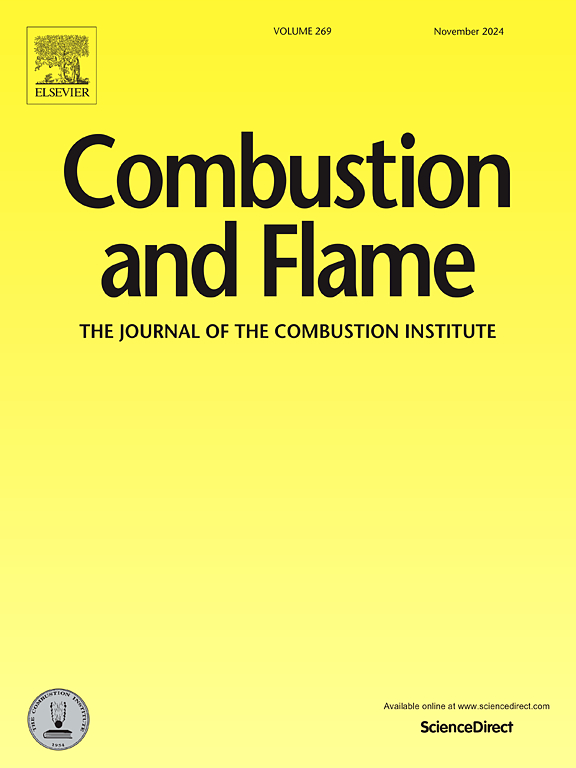Theoretical analysis of quasi-steady evaporation in compositionally distinct droplet pairs
IF 5.8
2区 工程技术
Q2 ENERGY & FUELS
引用次数: 0
Abstract
Liquid sprays consisting of interacting droplets with diverse compositions are prevalent in engineering applications and everyday life. Although extensive research has been conducted on multi-droplet interactions, most studies concentrate on scenarios involving identical compositions. In this study, we theoretically investigate the quasi-steady evaporation of compositionally distinct droplet pairs using the mass-flux potential model and a bispherical-coordinate approach. Two droplet temperature models under contrasting conditions – no-mixing and rapid-mixing – are examined. Based on these models, the realistic equilibrium temperatures of droplet pairs, accounting for evaporative cooling effects, are clarified. Asymptotic analysis, conducted for relatively large inter-droplet spacings, yields theoretical solutions for the distributions of potential function, temperature, and various components in the gas phase. The equilibrium droplet temperatures, local and cumulative evaporation rates, and interaction coefficients between droplets are determined. Findings reveal that in dual-droplet systems with varying compositions, the surface evaporation potential, temperature, and vapor mass fraction become non-uniform. This non-uniformity, in contrast to the uniform distribution observed in existing studies on identical compositions, intensifies with greater differences in droplet volatilities or reduced inter-droplet spacing. Furthermore, the equilibrium droplet temperatures and evaporation rates decrease due to the shielding effect from adjacent droplets, with smaller or less volatile droplets experiencing more significant impacts. The theoretical results align well with numerical simulations across a wide range of parameters, including liquid compositions, droplet sizes, and inter-droplet spacings. This study enhances the understanding of realistic evaporation dynamics in multi-droplet systems, especially those with diverse compositions. Additionally, while the current analysis focuses on pure vaporization, the flame-sheet assumption provides a theoretical basis for potentially extending this work to include combustion scenarios.
Novelty and Significance Statement: This study contributes novel theoretical insights into the quasi-steady evaporation processes of compositionally distinct droplet pairs, a subject that has received less attention compared to the extensive research on identical compositions. It unveils detailed asymptotic solutions that expose the non-uniform distributions of temperatures, vapor concentrations, and evaporation rates on droplet surfaces, presenting a significant contrast to the uniformity observed in prior studies. These findings deepen our understanding of evaporation dynamics in multi-droplet systems with varying compositions, which are prevalent in practical settings. The insights obtained from this study could influence the design and operational strategies of technologies in fields such as spray evaporation and combustion, thereby facilitating the development of more versatile and efficient systems.
求助全文
约1分钟内获得全文
求助全文
来源期刊

Combustion and Flame
工程技术-工程:化工
CiteScore
9.50
自引率
20.50%
发文量
631
审稿时长
3.8 months
期刊介绍:
The mission of the journal is to publish high quality work from experimental, theoretical, and computational investigations on the fundamentals of combustion phenomena and closely allied matters. While submissions in all pertinent areas are welcomed, past and recent focus of the journal has been on:
Development and validation of reaction kinetics, reduction of reaction mechanisms and modeling of combustion systems, including:
Conventional, alternative and surrogate fuels;
Pollutants;
Particulate and aerosol formation and abatement;
Heterogeneous processes.
Experimental, theoretical, and computational studies of laminar and turbulent combustion phenomena, including:
Premixed and non-premixed flames;
Ignition and extinction phenomena;
Flame propagation;
Flame structure;
Instabilities and swirl;
Flame spread;
Multi-phase reactants.
Advances in diagnostic and computational methods in combustion, including:
Measurement and simulation of scalar and vector properties;
Novel techniques;
State-of-the art applications.
Fundamental investigations of combustion technologies and systems, including:
Internal combustion engines;
Gas turbines;
Small- and large-scale stationary combustion and power generation;
Catalytic combustion;
Combustion synthesis;
Combustion under extreme conditions;
New concepts.
 求助内容:
求助内容: 应助结果提醒方式:
应助结果提醒方式:


